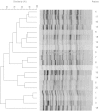Colistin-resistant Acinetobacter baumannii: beyond carbapenem resistance
- PMID: 25632010
- PMCID: PMC4462660
- DOI: 10.1093/cid/civ048
Colistin-resistant Acinetobacter baumannii: beyond carbapenem resistance
Abstract
Background: With an increase in the use of colistin methansulfonate (CMS) to treat carbapenem-resistant Acinetobacter baumannii infections, colistin resistance is emerging.
Methods: Patients with infection or colonization due to colistin-resistant A. baumannii were identified at a hospital system in Pennsylvania. Clinical data were collected from electronic medical records. Susceptibility testing, pulsed-field gel electrophoresis (PFGE), and multilocus sequence typing (MLST) were performed. To investigate the mechanism of colistin resistance, lipid A was subjected to matrix-assisted laser desorption/ionization mass spectrometry.
Results: Twenty patients with colistin-resistant A. baumannii were identified. Ventilator-associated pneumonia was the most common type of infection. Nineteen patients had received intravenous and/or inhaled CMS for treatment of carbapenem-resistant, colistin-susceptible A. baumannii infection prior to identification of colistin-resistant isolates. The 30-day all-cause mortality rate was 30%. The treatment regimen for colistin-resistant A. baumannii infection associated with the lowest mortality rate was a combination of CMS, a carbapenem, and ampicillin-sulbactam. The colistin-susceptible and -resistant isolates from the same patients were highly related by PFGE, but isolates from different patients were not, suggesting evolution of resistance during CMS therapy. By MLST, all isolates belonged to the international clone II, the lineage that is epidemic worldwide. Phosphoethanolamine modification of lipid A was present in all colistin-resistant A. baumannii isolates.
Conclusions: Colistin-resistant A. baumannii occurred almost exclusively among patients who had received CMS for treatment of carbapenem-resistant, colistin-susceptible A. baumannii infection. Lipid A modification by the addition of phosphoethanolamine accounted for colistin resistance. Susceptibility testing for colistin should be considered for A. baumannii identified from CMS-experienced patients.
Keywords: Acinetobacter baumannii; carbapenem resistance; colistin resistance; lipid A; molecular typing.
© The Author 2015. Published by Oxford University Press on behalf of the Infectious Diseases Society of America. All rights reserved. For Permissions, please e-mail: journals.permissions@oup.com.
Figures


Comment in
-
Editorial commentary: Polymyxin-resistant Acinetobacter baumannii: urgent action needed.Clin Infect Dis. 2015 May 1;60(9):1304-7. doi: 10.1093/cid/civ044. Epub 2015 Jan 28. Clin Infect Dis. 2015. PMID: 25632011 Free PMC article. No abstract available.
References
-
- Sievert DM, Ricks P, Edwards JR, et al. Antimicrobial-resistant pathogens associated with healthcare-associated infections: summary of data reported to the National Healthcare Safety Network at the Centers for Disease Control and Prevention, 2009–2010. Infect Control Hosp Epidemiol 2013; 34:1–14. - PubMed
-
- Garnacho-Montero J, Amaya-Villar R. Multiresistant Acinetobacter baumannii infections: epidemiology and management. Curr Opin Infect Dis 2010; 23:332–9. - PubMed
-
- Boucher HW, Talbot GH, Bradley JS, et al. Bad bugs, no drugs: no ESKAPE! An update from the Infectious Diseases Society of America. Clin Infect Dis 2009; 48:1–12. - PubMed
-
- Munoz-Price LS, Arheart K, Nordmann P, et al. Eighteen years of experience with Acinetobacter baumannii in a tertiary care hospital. Crit Care Med 2013; 41:2733–42. - PubMed
Publication types
MeSH terms
Substances
Grants and funding
LinkOut - more resources
Full Text Sources
Other Literature Sources

